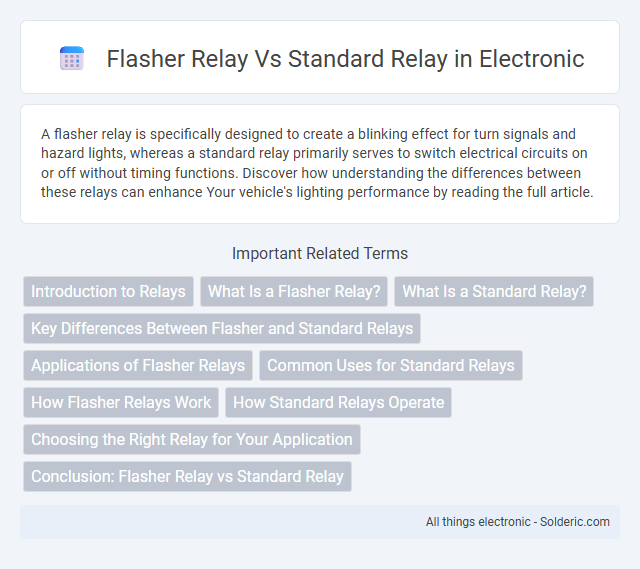A flasher relay is specifically designed to create a blinking effect for turn signals and hazard lights, whereas a standard relay primarily serves to switch electrical circuits on or off without timing functions. Discover how understanding the differences between these relays can enhance Your vehicle's lighting performance by reading the full article.
Comparison Table
| Feature | Flasher Relay | Standard Relay |
|---|---|---|
| Function | Controls blinking of turn signals and hazard lights | Switches electrical circuits on/off without blinking |
| Operation | Creates intermittent ON/OFF cycles for lights | Provides continuous ON or OFF state |
| Usage | Automotive lighting systems (turn signals, hazards) | Various electrical devices and systems |
| Power Consumption | Low to moderate, due to cyclic operation | Typically low, depends on load |
| Complexity | More complex, includes timing circuit | Simple switching mechanism |
| Output | Pulsed output (flashing) | Steady output (ON or OFF) |
| Common Applications | Turn signals, hazard warning lights | Starter motors, lighting, pumps, general switches |
| Cost | Generally higher than standard relays | Lower cost due to simpler design |
Introduction to Relays
Relays are essential electrical switches used to control high-power circuits with a low-power signal, enabling efficient and safe operation in automotive and industrial applications. Flasher relays are specialized relays designed to create a timed on-off flashing signal, primarily used for vehicle turn signals and hazard lights, unlike standard relays that simply open or close circuits without timing functions. Your choice between a flasher relay and a standard relay depends on whether you need intermittent flashing control or straightforward switching for your electrical system.
What Is a Flasher Relay?
A flasher relay is an electronic or electromechanical device designed to control the blinking operation of vehicle turn signal lights and hazard warning lights by intermittently interrupting the electrical current. Unlike a standard relay that simply switches electrical circuits on or off based on a steady signal, a flasher relay provides timed pulses to produce the characteristic flashing pattern. Your vehicle relies on the flasher relay to ensure clear, consistent signaling for safe driving and communication with other road users.
What Is a Standard Relay?
A standard relay is an electromechanical switch that uses an electromagnetic coil to open or close electrical contacts, enabling control of high-power circuits with a low-power signal. Commonly used in automotive and industrial applications, standard relays provide reliable on/off control for devices such as headlights, horns, and motors. Unlike flasher relays, standard relays do not produce intermittent signals but maintain a steady electrical connection when activated.
Key Differences Between Flasher and Standard Relays
Flasher relays are designed to create intermittent signals, commonly used in vehicle turn indicators and hazard lights, whereas standard relays provide a constant on/off switching function for various electrical circuits. Flasher relays typically include built-in timing mechanisms to control blinking frequency, while standard relays rely on external control to manage circuit activation. Your choice depends on whether your application requires timed blinking signals or simple switching operations.
Applications of Flasher Relays
Flasher relays are primarily used in automotive signaling systems to control turn indicators and hazard lights, providing the characteristic blinking pattern required for effective communication with other drivers. These relays help ensure your vehicle's lights flash at a consistent rate, enhancing safety during lane changes or emergency stops. Unlike standard relays, which simply switch electrical circuits on or off, flasher relays are specialized for timed, repetitive on-off cycles in lighting applications.
Common Uses for Standard Relays
Standard relays are widely used in automotive and industrial applications to control high-current circuits such as headlights, fuel pumps, and cooling fans. They enable low-current control switches to safely operate heavy electrical loads by switching power on and off. These relays are also essential in HVAC systems, industrial machinery, and home appliances for reliable and efficient electrical circuit management.
How Flasher Relays Work
Flasher relays operate by rapidly opening and closing the circuit to create a blinking effect in vehicle turn signals, using a bimetallic strip or electronic timer to regulate the on-off cycle. Unlike standard relays that simply switch the current on or off, flasher relays modulate the current flow to generate consistent intermittent flashes at a specific frequency, typically around 60 to 120 flashes per minute. This controlled blinking ensures visibility and safety, making flasher relays essential in automotive lighting systems.
How Standard Relays Operate
Standard relays operate by using an electromagnet to mechanically switch electrical circuits, allowing a low-power signal to control a high-power load. When current flows through the relay's coil, it creates a magnetic field that pulls a lever to open or close contacts, thereby enabling or interrupting the circuit. This switching mechanism ensures isolation between control and output circuits, making standard relays essential for controlling automotive lighting, motors, and other heavy-duty electrical devices.
Choosing the Right Relay for Your Application
Choosing the right relay for your application depends on the specific function you need; flasher relays are designed to intermittently switch circuits on and off, ideal for turn signals and hazard lights, while standard relays provide a continuous current for switching purposes. Your decision should consider the timing requirements, load capacity, and voltage rating to ensure compatibility and performance within your electrical system. Using a flasher relay in applications requiring a steady current can cause malfunction, so matching relay type to circuit demands is critical for reliability and safety.
Conclusion: Flasher Relay vs Standard Relay
Flasher relays are specifically designed to create intermittent on-off signals for automotive turn indicators, providing reliable, consistent blinking patterns essential for safety signaling. Standard relays, however, function as simple electrical switches, controlling high-power circuits without timing or flashing capabilities. Your choice depends on whether you need precise flash timing for indicators or straightforward circuit control.
Flasher relay vs standard relay Infographic

 solderic.com
solderic.com